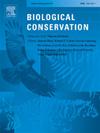To preserve, monitor or eradicate: Covert rewilding as an emerging conservation trilemma for wildlife managers
IF 4.9
1区 环境科学与生态学
Q1 BIODIVERSITY CONSERVATION
引用次数: 0
Abstract
Global biodiversity is currently facing an unprecedented extinction rate because of increased anthropogenic pressures, which often cause local or regional extirpations of wildlife populations. Once extinct from a given region, wildlife populations might be officially reintroduced upon the cessation of the threats that caused past declines. However, official translocations often undergo a lengthy assessment process and can be refused by environmental authorities due to various uncertainties related to expected benefits, potential impacts or long-term viability, as well as the risk-averse attitude exhibited by some decision makers. In response to these obstacles and the growing social consideration of official translocations, illegal actors are conducting unauthorized releases of threatened wildlife, which is referred to as covert rewilding. Covert rewilding is an emerging conservation issue that often involves several management challenges and complexities. Here, we provide a decision-making framework to guide management actions once covertly translocated populations are discovered. For this, we used three illegally translocated populations of threatened aquatic vertebrates in southeastern Iberia as case studies, aiming to illustrate the three available management options: to preserve, monitor, or eradicate. Moreover, we provide practical recommendations to tackle covert rewilding at its source and prevent further unauthorized translocations. Our study provides an overview of covert rewilding to increase the visibility of this conservation issue, as well as to advocate for the implementation of preventive actions as the most cost-effective management approach.
求助全文
约1分钟内获得全文
求助全文
来源期刊

Biological Conservation
环境科学-环境科学
CiteScore
10.20
自引率
3.40%
发文量
295
审稿时长
61 days
期刊介绍:
Biological Conservation is an international leading journal in the discipline of conservation biology. The journal publishes articles spanning a diverse range of fields that contribute to the biological, sociological, and economic dimensions of conservation and natural resource management. The primary aim of Biological Conservation is the publication of high-quality papers that advance the science and practice of conservation, or which demonstrate the application of conservation principles for natural resource management and policy. Therefore it will be of interest to a broad international readership.
 求助内容:
求助内容: 应助结果提醒方式:
应助结果提醒方式:


